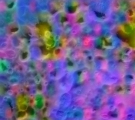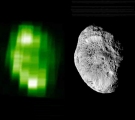Hyperion Flyby - September 2005
25 September 2005
The closest approach during the sole targeted flyby of Hyperion occurs on Monday, 26 September, at 02:25 UT at an altitude of 514 km above the surface and at a speed of 5.6 kilometres per second. Hyperion, roughly 1/3 the size of its round neighbour Tethys, is one of the smaller moons of Saturn and is shaped like a potato with the diameter of the long axis being 360 km and diameter of the short axis are around 250 km.This encounter together with the Tethys encounter on 24 September is set up with two manoeuvres: an apoapsis manoeuvre scheduled on 19 September, and an approach manoeuvre on 23 September.
These flybys are outbound from Saturn, with periapsis occurring on 23 September. Hyperion will be the sixth close encounter with icy satellites, after Phoebe, three Enceladus encounters (in orbit 3, non-targeted; orbit 4, orbit 11) and Tethys (orbit 15).
Science Activities
The Cassini project is interested in four broad science themes concerning Hyperion: its interior structure, surface characteristics and composition, investigation of volatiles and tenuous atmosphere if present, and interaction with Saturn's magnetosphere. In particular, this flyby will probe the following questions:
- Is Hyperion a rubble pile?
- What is the relationship between Phoebe, Iapetus and Hyperion?
- Cassini Plasma Spectrometer (CAPS)
CAPS will make measurements of the ion environment around Hyperion during the flyby. The spacecraft will likely encounter Hyperion downstream of the corotational flow, but this is not necessarily the case and will depend on the solar activity and the amount of solar pressure on Saturn's magnetosphere. - Composite Infrared Spectrometer (CIRS)
CIRS will make measurements to constrain the bolometric albedo, thermal inertial and volatile stability of Hyperion. The chaotic rotation of Hyperion suggests that the surface temperatures will be unlike those of bodies with normal rotations. CIRS will obtain spectra in the 10-500 μm wavelength region to search for compositionally diagnostic spectral features. - Imaging Science Subsystem (ISS)
ISS imaging of Hyperion (with resolution up to m/pix) will constrain the shape of Hyperion. - Radio and Plasma Wave Science (RPWS)
RPWS will look for evidence of a plasma source at Hyperion, and examine the plasma wave spectrum for evidence of magnetosphere-moon interactions. RPWS will also look for signatures of dust impacts. - Radio Science Subsystem (RSS)
RSS measurements on the inbound and outbound legs of the flyby will determine the mass of Hyperion. - Ultraviolet Imaging Spectrograph (UVIS)
UVIS will investigate the surface composition of Hyperion and study the water ice grain sizes. Ultraviolet spectra will be studied to look for evidence of volatile activity contributing to a tenuous atmosphere. - Visible and Infrared Mapping Spectrometer (VIMS)
VIMS will obtain infrared-visible spectra that can be used to study the surface composition of Hyperion. VIMS data will be used to perform grain size mapping across the surface and make compositional maps of Hyperion.
Observation Results
Cassini Instrument: Visual and Infrared Mapping Spectrometer (VIMS)
|
Date: 4 July 2007 Credit: NASA/JPL/University of Arizona/Ames Image Notes: False-colour composite (blue=H2O, red=CO2, green=CN) of composition of part of Hyperion's surface |
 |
Cassini Instrument: Ultraviolet Imaging Spectrograph (UVIS)
|
Date: 4 July 2007 Credit: NASA/JPL/University of Colorado/Space Science Institute Image Notes: UV map (left), where the brightest regions are exposed water ice, compared with visual image (right) |
 |

